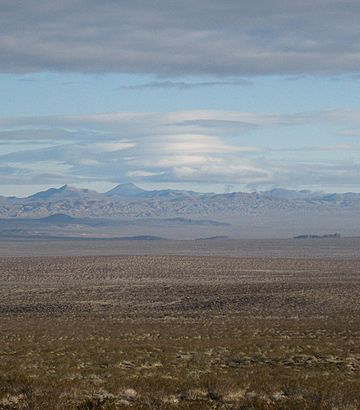Kramer Hills facts for kids
Quick facts for kids Kramer Hills |
|
|---|---|

Lenticular clouds above Kramer Hills
|
|
| Highest point | |
| Elevation | 3,346 ft (1,020 m) |
| Geography | |
| Country | United States |
| State | California |
| Region | Mojave Desert |
| District | San Bernardino County |
| Range coordinates | 34°53′48.928″N 117°30′33.198″W / 34.89692444°N 117.50922167°W |
| Topo map | USGS Kramer Junction |
The Kramer Hills are a small group of hills found in the Mojave Desert. This desert area is in the northwestern part of San Bernardino County, in southern California. These hills are not very tall, but they stand out in the mostly flat desert landscape.
Contents
What are the Kramer Hills?
The Kramer Hills are a low mountain range. They are a natural feature of the desert. They are made up of many small hills and rocky outcrops. The highest point in the Kramer Hills is about 3,346 feet (1,020 meters) above sea level. This makes them much smaller than large mountains.
Where are the Kramer Hills Located?
You can find the Kramer Hills just south of a place called Kramer Junction. They are also southeast of another town, Boron. A major road, U.S. Route 395, actually cuts right through the middle of these hills. This road helps people travel through the desert.
How Were the Hills Formed?
Like many hills and mountains, the Kramer Hills were formed over millions of years. They are part of the Mojave Desert's geology. This area has seen a lot of tectonic plate movement. This movement causes the Earth's crust to fold and break. Over time, these forces pushed up the land, creating the hills we see today. The rocks in the Kramer Hills are mostly igneous and metamorphic rocks. These rocks are very old.
Life in the Desert: Plants and Animals
Even though the Mojave Desert seems dry, many plants and animals call the Kramer Hills home. They have special ways to survive in the hot, dry climate. The hills provide different habitats. These habitats include rocky slopes and sandy washes.
Desert Plants You Might See
The plants in the Kramer Hills are tough. They are adapted to living with very little water. Some common plants include:
- Creosote bush: This is a very common desert shrub. It has small, waxy leaves. These leaves help it save water.
- Joshua tree: These iconic trees are a symbol of the Mojave Desert. They have spiky leaves and unique shapes.
- Cactus: Many types of cacti grow here. They store water in their stems. Their spines protect them from animals.
- Mojave yucca: Similar to the Joshua tree, this plant has stiff, sword-like leaves.
Animals of the Kramer Hills
Many animals live in the Kramer Hills. They are often active at night. This helps them avoid the heat of the day. Some animals you might find include:
- Desert tortoise: This is a protected species. They dig burrows to escape the heat.
- Coyote: These clever animals hunt small prey. They can be seen throughout the desert.
- Jackrabbit: These rabbits have very long ears. Their ears help them cool down.
- Roadrunner: This fast bird runs along the ground. It hunts lizards and snakes.
- Lizards and snakes: Many types of reptiles live here. They are well-suited to the desert heat.
- Birds: Various birds, like ravens and hawks, can be seen flying overhead.
Exploring the Kramer Hills
The Kramer Hills are part of an area managed by the Bureau of Land Management (BLM). This means the land is public. People can visit it for outdoor activities.
Roads and Access
As mentioned, U.S. Route 395 goes right through the hills. This makes them easy to access. There are also many unpaved roads and trails. These trails are often used by off-road vehicles. They are also great for hiking and exploring.
Protecting the Land
The Bureau of Land Management works to protect the natural environment of the Kramer Hills. They manage the land for many uses. These uses include recreation, wildlife habitat, and historical preservation. Visitors are encouraged to respect the desert environment. This includes staying on marked trails and not disturbing plants or animals.


